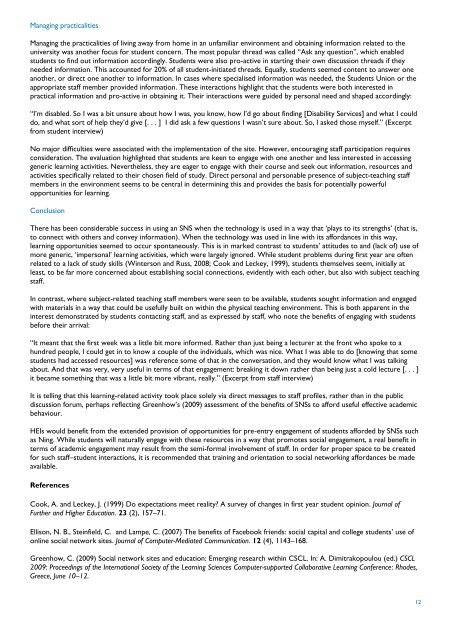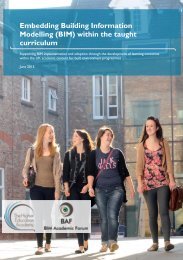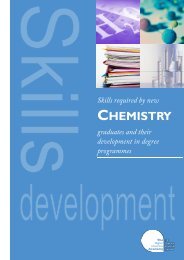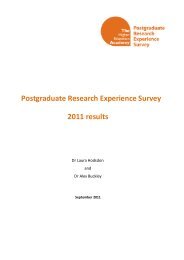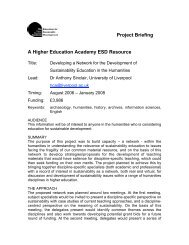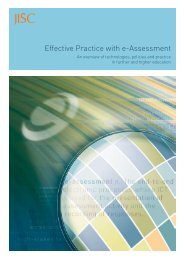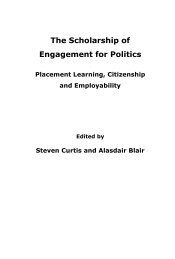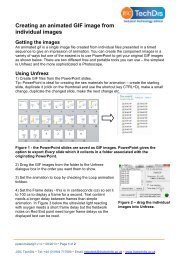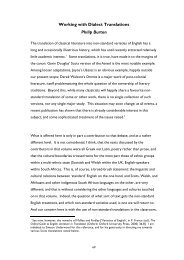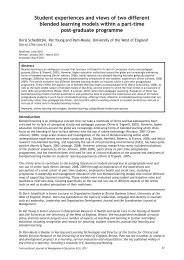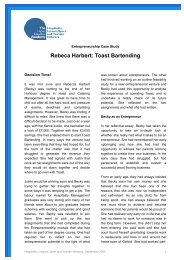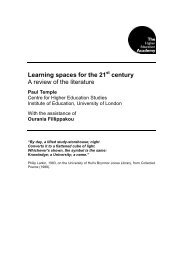Compendium of effective practice in higher education: Volume 2
Compendium of effective practice in higher education: Volume 2
Compendium of effective practice in higher education: Volume 2
You also want an ePaper? Increase the reach of your titles
YUMPU automatically turns print PDFs into web optimized ePapers that Google loves.
Manag<strong>in</strong>g practicalities<br />
Manag<strong>in</strong>g the practicalities <strong>of</strong> liv<strong>in</strong>g away from home <strong>in</strong> an unfamiliar environment and obta<strong>in</strong><strong>in</strong>g <strong>in</strong>formation related to the<br />
university was another focus for student concern. The most popular thread was called “Ask any question”, which enabled<br />
students to f<strong>in</strong>d out <strong>in</strong>formation accord<strong>in</strong>gly. Students were also pro-active <strong>in</strong> start<strong>in</strong>g their own discussion threads if they<br />
needed <strong>in</strong>formation. This accounted for 20% <strong>of</strong> all student-<strong>in</strong>itiated threads. Equally, students seemed content to answer one<br />
another, or direct one another to <strong>in</strong>formation. In cases where specialised <strong>in</strong>formation was needed, the Students Union or the<br />
appropriate staff member provided <strong>in</strong>formation. These <strong>in</strong>teractions highlight that the students were both <strong>in</strong>terested <strong>in</strong><br />
practical <strong>in</strong>formation and pro-active <strong>in</strong> obta<strong>in</strong><strong>in</strong>g it. Their <strong>in</strong>teractions were guided by personal need and shaped accord<strong>in</strong>gly:<br />
“I’m disabled. So I was a bit unsure about how I was, you know, how I’d go about f<strong>in</strong>d<strong>in</strong>g [Disability Services] and what I could<br />
do, and what sort <strong>of</strong> help they’d give [. . . ] I did ask a few questions I wasn’t sure about. So, I asked those myself.” (Excerpt<br />
from student <strong>in</strong>terview)<br />
No major difficulties were associated with the implementation <strong>of</strong> the site. However, encourag<strong>in</strong>g staff participation requires<br />
consideration. The evaluation highlighted that students are keen to engage with one another and less <strong>in</strong>terested <strong>in</strong> access<strong>in</strong>g<br />
generic learn<strong>in</strong>g activities. Nevertheless, they are eager to engage with their course and seek out <strong>in</strong>formation, resources and<br />
activities specifically related to their chosen field <strong>of</strong> study. Direct personal and personable presence <strong>of</strong> subject-teach<strong>in</strong>g staff<br />
members <strong>in</strong> the environment seems to be central <strong>in</strong> determ<strong>in</strong><strong>in</strong>g this and provides the basis for potentially powerful<br />
opportunities for learn<strong>in</strong>g.<br />
Conclusion<br />
There has been considerable success <strong>in</strong> us<strong>in</strong>g an SNS when the technology is used <strong>in</strong> a way that ‘plays to its strengths’ (that is,<br />
to connect with others and convey <strong>in</strong>formation). When the technology was used <strong>in</strong> l<strong>in</strong>e with its affordances <strong>in</strong> this way,<br />
learn<strong>in</strong>g opportunities seemed to occur spontaneously. This is <strong>in</strong> marked contrast to students’ attitudes to and (lack <strong>of</strong>) use <strong>of</strong><br />
more generic, ‘impersonal’ learn<strong>in</strong>g activities, which were largely ignored. While student problems dur<strong>in</strong>g first year are <strong>of</strong>ten<br />
related to a lack <strong>of</strong> study skills (W<strong>in</strong>terson and Russ, 2008; Cook and Leckey, 1999), students themselves seem, <strong>in</strong>itially at<br />
least, to be far more concerned about establish<strong>in</strong>g social connections, evidently with each other, but also with subject teach<strong>in</strong>g<br />
staff.<br />
In contrast, where subject-related teach<strong>in</strong>g staff members were seen to be available, students sought <strong>in</strong>formation and engaged<br />
with materials <strong>in</strong> a way that could be usefully built on with<strong>in</strong> the physical teach<strong>in</strong>g environment. This is both apparent <strong>in</strong> the<br />
<strong>in</strong>terest demonstrated by students contact<strong>in</strong>g staff, and as expressed by staff, who note the benefits <strong>of</strong> engag<strong>in</strong>g with students<br />
before their arrival:<br />
“It meant that the first week was a little bit more <strong>in</strong>formed. Rather than just be<strong>in</strong>g a lecturer at the front who spoke to a<br />
hundred people, I could get <strong>in</strong> to know a couple <strong>of</strong> the <strong>in</strong>dividuals, which was nice. What I was able to do [know<strong>in</strong>g that some<br />
students had accessed resources] was reference some <strong>of</strong> that <strong>in</strong> the conversation, and they would know what I was talk<strong>in</strong>g<br />
about. And that was very, very useful <strong>in</strong> terms <strong>of</strong> that engagement: break<strong>in</strong>g it down rather than be<strong>in</strong>g just a cold lecture [. . . ]<br />
it became someth<strong>in</strong>g that was a little bit more vibrant, really.” (Excerpt from staff <strong>in</strong>terview)<br />
It is tell<strong>in</strong>g that this learn<strong>in</strong>g-related activity took place solely via direct messages to staff pr<strong>of</strong>iles, rather than <strong>in</strong> the public<br />
discussion forum, perhaps reflect<strong>in</strong>g Greenhow’s (2009) assessment <strong>of</strong> the benefits <strong>of</strong> SNSs to afford useful <strong>effective</strong> academic<br />
behaviour.<br />
HEIs would benefit from the extended provision <strong>of</strong> opportunities for pre-entry engagement <strong>of</strong> students afforded by SNSs such<br />
as N<strong>in</strong>g. While students will naturally engage with these resources <strong>in</strong> a way that promotes social engagement, a real benefit <strong>in</strong><br />
terms <strong>of</strong> academic engagement may result from the semi-formal <strong>in</strong>volvement <strong>of</strong> staff. In order for proper space to be created<br />
for such staff–student <strong>in</strong>teractions, it is recommended that tra<strong>in</strong><strong>in</strong>g and orientation to social network<strong>in</strong>g affordances be made<br />
available.<br />
References<br />
Cook, A. and Leckey, J. (1999) Do expectations meet reality? A survey <strong>of</strong> changes <strong>in</strong> first year student op<strong>in</strong>ion. Journal <strong>of</strong><br />
Further and Higher Education. 23 (2), 157–71.<br />
Ellison, N. B., Ste<strong>in</strong>field, C. and Lampe, C. (2007) The benefits <strong>of</strong> Facebook friends: social capital and college students’ use <strong>of</strong><br />
onl<strong>in</strong>e social network sites. Journal <strong>of</strong> Computer-Mediated Communication. 12 (4), 1143–168.<br />
Greenhow, C. (2009) Social network sites and <strong>education</strong>: Emerg<strong>in</strong>g research with<strong>in</strong> CSCL. In: A. Dimitrakopoulou (ed.) CSCL<br />
2009: Proceed<strong>in</strong>gs <strong>of</strong> the International Society <strong>of</strong> the Learn<strong>in</strong>g Sciences Computer-supported Collaborative Learn<strong>in</strong>g Conference: Rhodes,<br />
Greece, June 10–12.<br />
12


